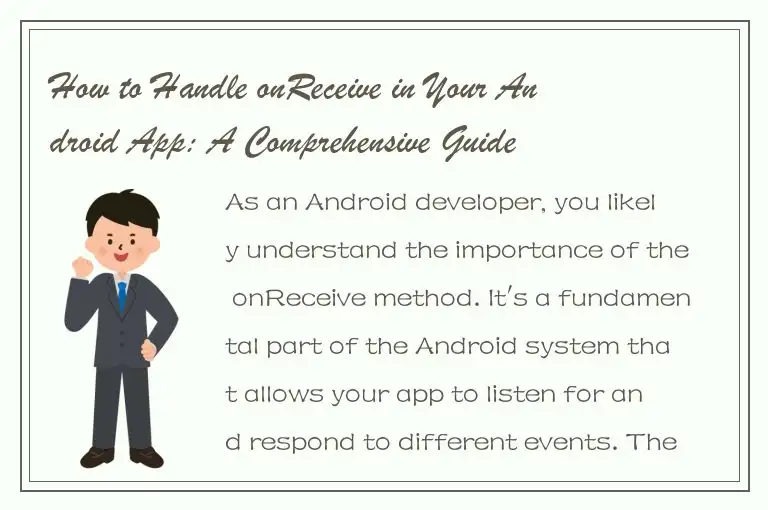As an Android developer, you likely understand the importance of the onReceive method. It's a fundamental part of the Android system that allows your app to listen for and respond to different events. The onReceive method is used to handle Intent objects that are broadcasted by the system or other apps. These Intent objects can be used to trigger different actions within your app, such as starting a service or launching an activity.

However, handling onReceive can be confusing, especially for new developers. In this comprehensive guide, we'll discuss the various aspects of onReceive, including its definition, usage, lifecycle, and best practices to make sure that you're able to handle it with ease.
Understanding the onReceive Method
The onReceive method is used in Android programming to handle incoming broadcasted Intents. This method is a member of the BroadcastReceiver class, which is responsible for receiving these broadcasts and allowing you to perform an action in response. Essentially, the onReceive method is invoked every time a broadcast message is sent that your app is registered to receive.
Here's what the method signature looks like:
```
public void onReceive(Context context, Intent intent) {
// Perform action here
}
```
The onReceive method takes in two parameters. The first parameter is the context, which is the current state of the app. The second parameter is the Intent object, which contains the information needed to perform the action.
Usage of the onReceive Method
The onReceive method is used to handle any incoming broadcast event that is registered with the BroadcastReceiver class. These events can be system-generated or app-specific, such as when the user changes the volume or checks the battery status. Here's an example of how to register an event to be received by the BroadcastReceiver:
```
IntentFilter filter = new IntentFilter(Intent.ACTION_BATTERY_CHANGED);
BatteryReceiver receiver = new BatteryReceiver();
registerReceiver(receiver, filter);
```
This code registers the BatteryReceiver class to listen for the ACTION_BATTERY_CHANGED broadcast event. Whenever the battery level changes, the onReceive method in the BatteryReceiver class will be invoked.
Lifecycle of the onReceive Method
The onReceive method has a very short lifecycle. When the broadcast event is received, the system invokes the onReceive method, which must then complete its execution within a short period of time. During this time, you must execute your code and then allow the method to finish. If your code takes longer than about 10 seconds to execute, the system may kill your app.
Best Practices for Handling onReceive
Here are some best practices to consider when handling onReceive:
1. Avoid doing heavy processing in onReceive. Since the method has a short lifecycle, you should avoid performing any heavy work in onReceive. Instead, you can start a Service or AsyncTask to perform the actual processing.
2. Unregister your BroadcastReceiver when not in use. It's important to unregister the BroadcastReceiver when it's not needed to prevent any unnecessary execution.
3. Handle exceptions. Make sure to handle any exceptions that may be thrown during execution. A crash can halt your app or cause it to misbehave.
4. Follow the single responsibility principle. Each BroadcastReceiver should handle one specific event. This will make it easier to maintain and debug your code.
In Conclusion
The onReceive method is a powerful feature of the Android system that allows your app to listen for and respond to different events. Understanding its usage, lifecycle, and best practices is crucial to creating reliable and stable apps. By following these guidelines, you'll be able to handle onReceive with confidence and ensure that your app runs smoothly.




 QQ客服专员
QQ客服专员 电话客服专员
电话客服专员